Visual AIDS Research Fellow aliwen considers camp and sensuality in the photography of Nelson Edwin Rodriguez (1972–1995), as part of a series of original scholarly writing engaging with the Visual AIDS Archive Project. This article was published to coincide with what would have been Nelson's 51st birthday on February 16, 2023.


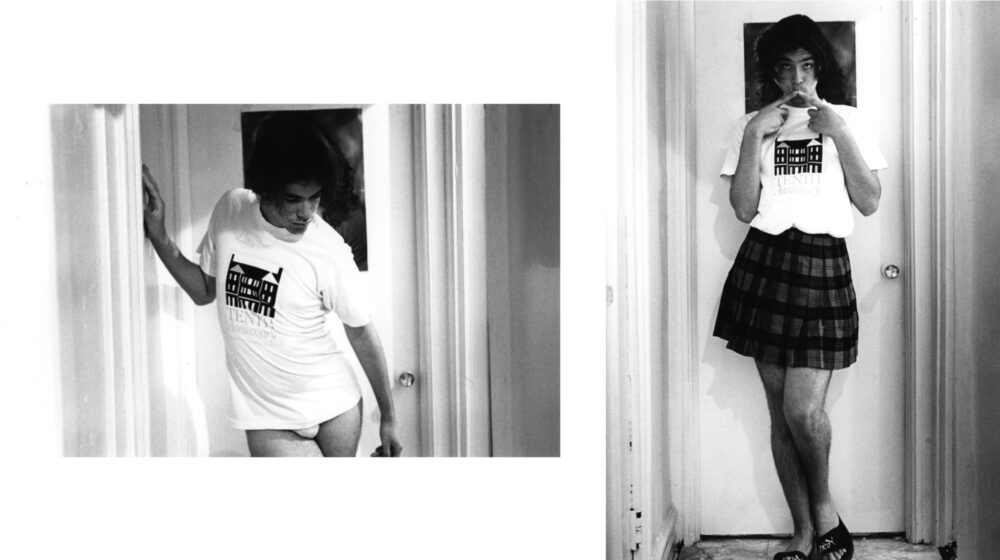
Nelson Edwin Rodriguez: Love, Loss, Memory
aliwen
I understand this familial and cultural inheritance as something ephemeral and not always conscious. It exists as a sustained and potentially haunted drive to revisit, rework, and revise the gaps in this inheritance, trying to find that touch across time even if it’s through what remains.1
Emily Colucci
I am struck with a quick onset of emotions every time that I look at one of Nelson Edwin Rodriguez’s photographs.2
I can’t deny that I feel a strong sense of hot, visceral rage, right in the middle of my guts. It twists and churns, until it begins to radiate throughout my lower torso, probably until I move on to looking at something else. Rage for a young queer life lost amid systemic negligence and inaccessible health care, at a time when antiretroviral cocktails were beginning to become available, but with a prohibitively steep price tag.
But I am also amazed by the timeless appeal of these photographs, their garbo, sensuality. They have an irreducible sense of elegance that is not derived from material opulence―although Nelson Rodriguez was quite the campy artist, interested more so in the exuberance of gender found in drag queens and in New York city nightlife than in “real” luxury. His tools appear to be very austere: a single-lens reflex camera and black and white film stock that is relatively easy to develop oneself at the community photo lab. But when combined with the simple lines of Nelson’s intuitive composition, they provide a brutal sense of realism, oddly perfumed with the quintessence of old-Hollywood glamor. All of these features play off the bare corpulence of the naked queer bodies, the wigs, the heels, the raw and honest portraits, of friends, of fellow artists, of queens and hunks, imbuing his entire oeuvre with an ironic wink at the silver screen sirens of yesterday.
As the weeks and months have passed since I first started cohabiting with the work and the archive of Nelson, I also feel another type of longing. This could be described as the longing of a tía, of an abuela, or even an amiga, a sort of femme, sissy, or matriarchal urge for embracing and protecting a fragile member of the community, that―at the risk of sounding condescending, or excessively sensitive to the point of gaucheness―I believe might be a useful tool when unpacking the latinx3 experiences surrounding Nelson’s short and yet stellar career.
As an advocate, researcher, and as a human being: I cling to my rage, to seduction, and to tenderness, seeking to detangle these brown-tinted affects and histories of art as a means to make something new, to tell a story. To tell a story meant to be told, retold, repeated, plagiarized, trafficked from many mouths belonging to many different bodies. Possibly even our own story, whatever “our own” might mean here.
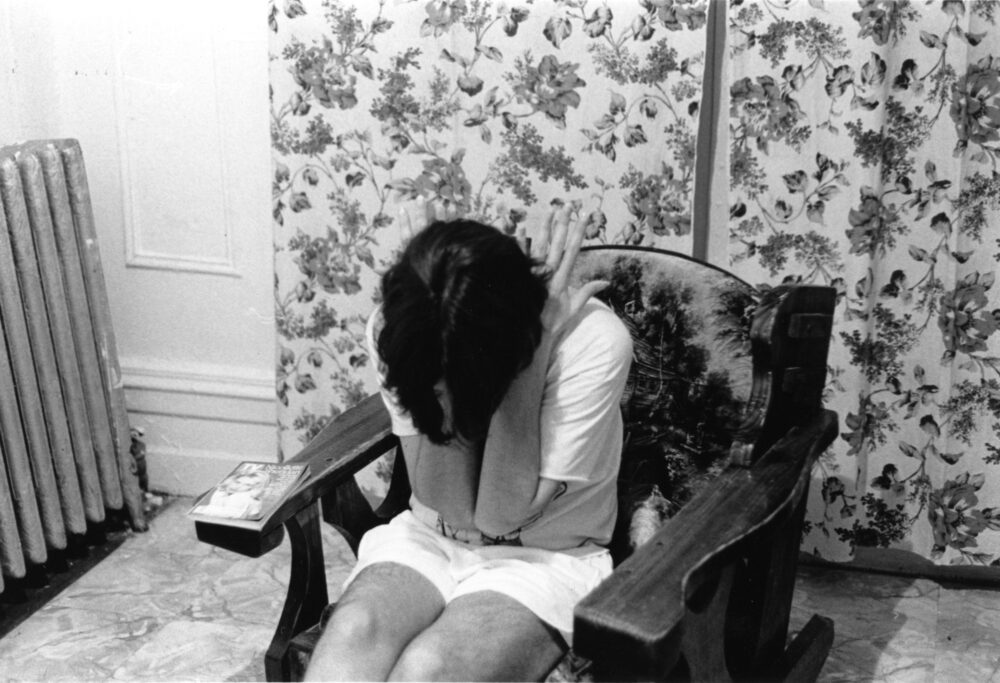
Queer Youth Services and Coming of Age in New York in the 90’s
They are boxes that we fill up little by little with printed pages, flyers, and memories inherited from disappeared people, with the intention of conserving the graphic signs of an affective memory, of sharing it with others and making them known. In summary, acknowledging, in other words, to make some objects, too evanescent, too light, too insignificant and miniscule, count.4
Élisabeth Lebovici
One of the most striking features of Nelson’s oeuvre is the simple yet elegant potency of his photography. Always imbued with an everyday that magically evokes an otherworldliness; rather another-worldliness, or (better yet) a profound sense of the then and there of queer futurity.5 With this, I mean that these images―although highly charged by their context of production―carry a sort of newness and nowness that is built from a specific queer yearning. Yes, under scrutiny we can easily deduce the crevices, the unpolished decor that signals Nelson’s apartment in the Bronx at a specific moment in time. But something else is operating here: a sensitive machine carefully revealing and concealing the multiple areas of desire aroused by a young queer latinx artist, questioning gender and its myriad signifiers.
Nelson picked up photography at the Hetrick-Martin Institute (founded in 1979), a LGBTQIA+ support center once located right in front of the West Side Piers and the first non-governmental organization in the United States to provide youth services6 and shelter for queer youth.7 The Piers were notorious as a spot for gay cruising and hooking as well as transgender sex work, a meeting ground for many marginalized communities. It was an iconic relic of New York’s grimey underbelly before the Giuliani/Bloomberg crackdown against so called “sexual deviancy” in the public sphere. Amongst the queer havens such as Greenwich Village and the Piers, different institutions and community centers targeting queer youth sought to provide shelter and to educate. This was the case of the Hetrick-Martin, located back then on West Street, quite close to the Greenwich Village Youth Council's drop-in center, the Neutral Zone (founded in 1991), which also provided shelter, counseling, and various programs for young queers in precarious situations.
Nelson’s family is Boricua, and he was born in Puerto Rico in 1972.8 Like many others before them, the Rodriguezes moved to New York―probably while Nelson was still very young―looking for better opportunities, and ended up settling in the Bronx. According to the creatives Boris Torres and Ira Sachs,9
“[Nelson] loved to dress in drag, but when he went home to the Bronx, he would put on his boots and sweatshirt, and try to stay under the radar, become invisible (he learned to walk so he wouldn't swish).”
Nelson’s relation to his own queerness as well as the larger queer community was tinted by his ethnic and territorial background, in which the larger sexist and homophobic tendencies in American society became conjugated with the hyper-policing of masculinity that often occurs in latinx machismo culture, deeply rooted in Catholicism and other factors. It is no surprise that, coming to his individual and sexual maturation in his late teens at the end of the 80’s, Nelson would reach out to New York’s queer havens such as the East Village and the Piers, seeking acceptance and wider possibilities for gender expression in young people similar to him.
Nelson was part of the first generation to enroll in a photography course taught at the Hetrick-Martin by photographer and advocate Lisa Ross.10 The course began in 1990, after the Institute received a donation that had the sole purpose of stimulating photography amongst queer youth. With a shoestring budget of about $500, Lisa was tasked with adapting a closet previously used to store condoms for free distribution and turn it into a DIY photographic darkroom. Going into the closet in order to come out, if you will. Lisa would receive camera donations in order to lend the equipment to the young photographers in training, most of them people of color; apart from Nelson, others such as Bruce Burgos from the House of Pendavis and Junior Vargas―better known as Chleo―from the House of Infinity, participated in that first class.
In 1991, the photography course expanded from a summer program to an ongoing class hosted two days a week thanks to a donation by the Ryan White Foundation11 as well as the Rockefeller Foundation. Lisa taught students the basic science of the camera: f-stop and shutter speed, as well as the chemistry of developing and printing, and even the framing and mounting of their own works, which they exhibited in countless collective exhibitions. Lisa encouraged their students to use photography as a means of introspection, to explore their own voices as people coming from marginalized communities. In Lisa’s own words, to “Look inside with the camera.” The course continued until around the year 2007, when digital technology started taking over the analog.
In the second year of this photo program, Luna Luis Ortiz12, a young community educator and fellow Boricua from the house of Khan, also started learning photography, right after Nelson had taken part in the course. Contracting HIV from his first sexual encounter with a much older man at the age of 14 in 1986, Luna took the Minolta SRT 200 gifted to him for his 13th birthday and started documenting his world and himself. Photography became a way to cope with the existential dread of the two-year life expectancy that his doctor predicted. Luna went on to become an amazing creative in his own right, and he deserves a separate chapter all of his own. In 1999, Luna began teaching the Hetrick-Martin’s photography course until circa 2007. During this time he found and saved some of Nelson’s prints that were wasting away in the Institute’s storage. Other photographs by Nelson were kept by Barbara Bickhart, an artist and theater and performance educator who taught Nelson, and later became the executor of his estate.13
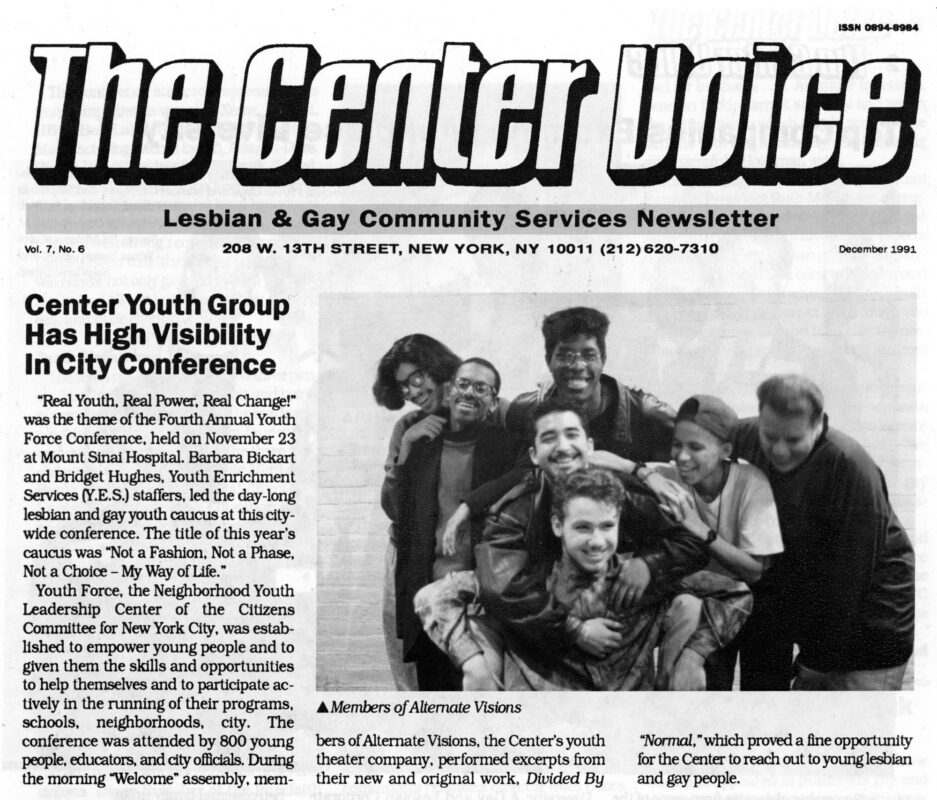
As Director of Youth Enrichment Services (YES) at the Lesbian & Gay Community Services Center―or simply “the Center”―Barbara Bickhart founded the Alternate Visions Theatre Troupe of Lesbian and Gay Youth in the year 1989. Nelson was an active member of the troupe, probably since its inception. This was a socially engaged project, in which Barbara and her partner Bridget Hughes would direct a group of young talents who would collaboratively write and perform original pieces that involved autobiographical exploration, comedy, and dance. For instance, an issue of the Center’s news publication from late 1991 describes how the Alternate Visions Troupe presented excerpts from their original piece Divided by “Normal” at the Fourth Annual Youth Force Conference in New York on November 23rd of that year.14 On December 9th, 1991, the Troupe presented the full piece at the La MaMa’s Club space at 74A East 4th Street. The playbill from the La MaMa performance notes that the Center’s YES program was funded by the New York State Division of Alcoholism and Alcohol Abuse, suggesting that theater practice was used as a means for sobriety for the young queers involved. Another playbill in Nelson’s archive advertises a 1992 performance by Alternate Visions, It’s Not the Shoes …That Dance Themselves to Pieces―A Queer Fairy Tale at the WOW Cafe (59 East 4th Street). The performers were asked to contribute a blurb about themselves for the brochure, and Nelson’s reads humorously:
Is… I am… Who am I? That’s a good question. When I find out I’ll let you know. They call me The Counselor…
In another brochure, we find evidence of a second performance from the trope at the WOW Cafe in 1993, this time titled Sweet Lemon Juice, Broken Glass. Nelson’s new blurb reads:
I am Nelson. Presiding Counselor to the House of Enterprise. Keeper of the Sacred Chalice of Riix, and Holder of the Seven Rings of Betazed, and who the hell are you? Half-Human and Half-Betazed, I can sense your emotions as you feel them. Being a veteran of the Alternate Vision Theatre Troupe, this ability comes in handy. When I’m not amongst the stars I enjoy writing, acting, performing and being creative. Being part of this ensemble has been great fun. I’ve made some new and beautiful friends. Forever in my heart. May you live long and prosper. I love you Barbara and Bridget.
This same pamphlet explains that: “All events are at the Center and are Alcohol and Drug-free. All events are FREE for young people 22 and Under,” reinforcing the sobriety-focused mission of the youth program.15
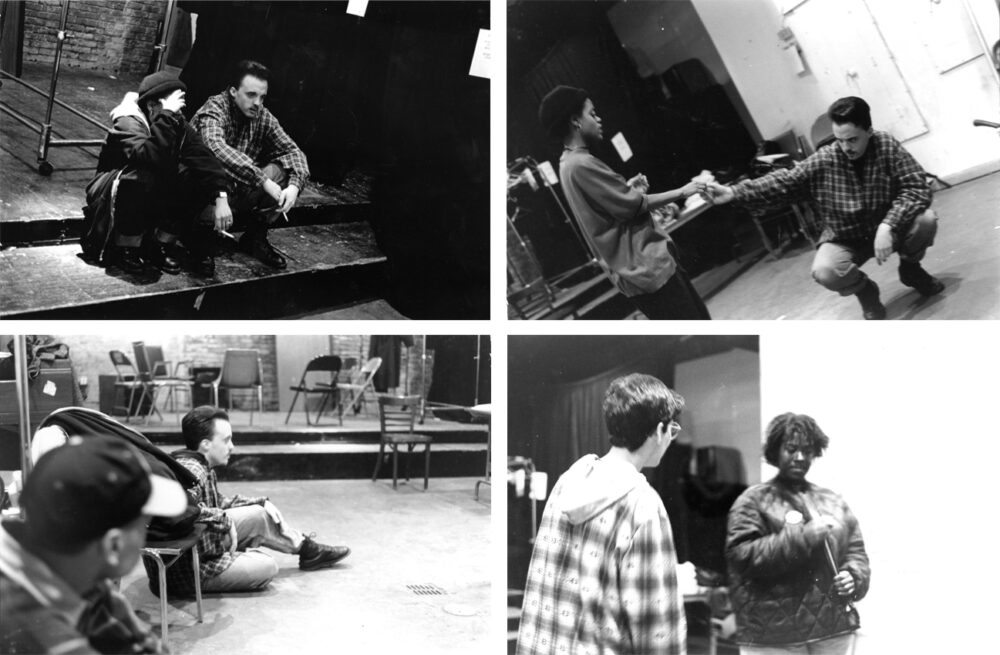
It was among the other young folks of color that frequented the Piers, as well as the Hetrick-Martin and the Neutral Zone, where Nelson found his queer community. When they were not out in the Central Park Ramble cruising or dancing, they were at the Piers voguing to the music coming out of someone’s boombox. Although not really a voguer himself, Nelson was a lover of drag and a huge trekkie, which is the endearing term used to describe the fans of the television series Star Trek and its contingent fictional universe. Nelson was such a huge trekkie that he was nicknamed “The Counselor” by his friends, inspired by the female character of Deanna Troi, half human and half of the Betazed people: known for their telepathic powers that allow them to empathize with the emotions of others.16 He even named his drag persona Morgana Troi after the aforementioned science fiction series. Nelson and his trekkie friend group even started what today would be known as a “kiki house” called the House of Enterprise around 1993, which is another reference to Star Trek.
If not out in Greenwich Village or at The Piers, Nelson and his contemporaries would hang out at the Hetrick-Martin while participating in their different creative programs until about 6:00 PM, when the Institute would usually close operations for the day. Then, many of them would go to the Neutral Zone (better known amongst attendees as “Brats”), which would open at around 3:00 PM, where a lot of homeless and queer youths would gather until it would close at midnight. Nelson and his friends would kiki, vogue, practice runway and other categories of Ballroom, or simply hang out and avoid the adversities of New York weather during the colder seasons. In the early 90’s, Luna Ortiz began hosting his Luna’s Follies drag shows at the Neutral Zone, where Nelson performed the songs of Bette Midler. A VHS tape kept by Luna shows fellow Boricua Milton Garcia17 from the House of Ninja voguing in the Old Way at Brats. Milton Garcia developed as an incredible artist himself, not only as a vogue performer but also as an illustrator, documenting in countless drawings his own experience and those of other queer people of color: celebrating their explorations of gender as well as mourning the loss of many close ones due to HIV/AIDS.
Nelson passed away suddenly on November 14th, 1995 due to AIDS-related complications at the early age of twenty three. Being able to interview some of the people that knew and interacted with Nelson in his lifetime, I got the sense that he struggled immensely with his HIV status, and would generally keep this information to himself or to a very limited group of people. Luna Ortiz only found out about Nelson's diagnosis because he also lived in the Bronx and he happened to run into Nelson in 1993 or 1994 at the Montefiore Medical Center in their neighborhood, where they were both obtaining treatment for their HIV. In a memorial text, Luna wrote about Nelson’s struggles with his diagnosis, probably trying to make sense of the loss as a young positive man himself:
What I remember most about my friend Nelson Rodriguez was his fear of AIDS and his fear of disclosure. He was terrified with what AIDS did to so many of our friends and he was terrified of his friends knowing his status. I think he felt that if we knew he had AIDS then we would not love him just the same. He must have witnessed our other friends being shunned by friends and family. […]
We both hung out at the Hetrick-Martin Institute, where we both embarked on developing our talents as all round artists. We did everything. We were actors, photographers and part-time drag queens. His drag name was Morgana Troy. He loved “Star Trek” and the movie “Beaches” with Bette Midler. Our friendship was based on our love for art. He was one hell of a performer and he expressed it all in his work.
He had already known my HIV status, but we didn’t talk about it. As time got older I noticed he pushed me and his other friends away. He started to show signs that he had AIDS but he never talked about it. I later learned he couldn’t stand it that I was so open and free regarding my HIV status.
One day I had an appointment at an adolescent clinic in the Bronx. There he was sitting in the doctor’s office. When he saw me he was shocked. He acted as if he had seen a ghost. I was shocked that he hadn’t told me anything. I wondered why. [...] Later our doctor came over to me to talk to me about confidentiality. Nelson didn’t want me to know. Here my own sister didn’t trust me. Much more time went by and Nelson got weaker and weaker. He found the strength to be in a movie, “The Incredible Adventure of Two Girls in Love,” and a PBS special for World AIDS Day and a few drag shows with the Luna Follies at the Neutral Zone.18
Milton Garcia described Nelson’s passing as one of the first AIDS-related deaths among the friends he had met at Brats, the Hetrick-Martin, and YES youth services, and recalled that the entire community had been left with a deep sense of loss and mourning.
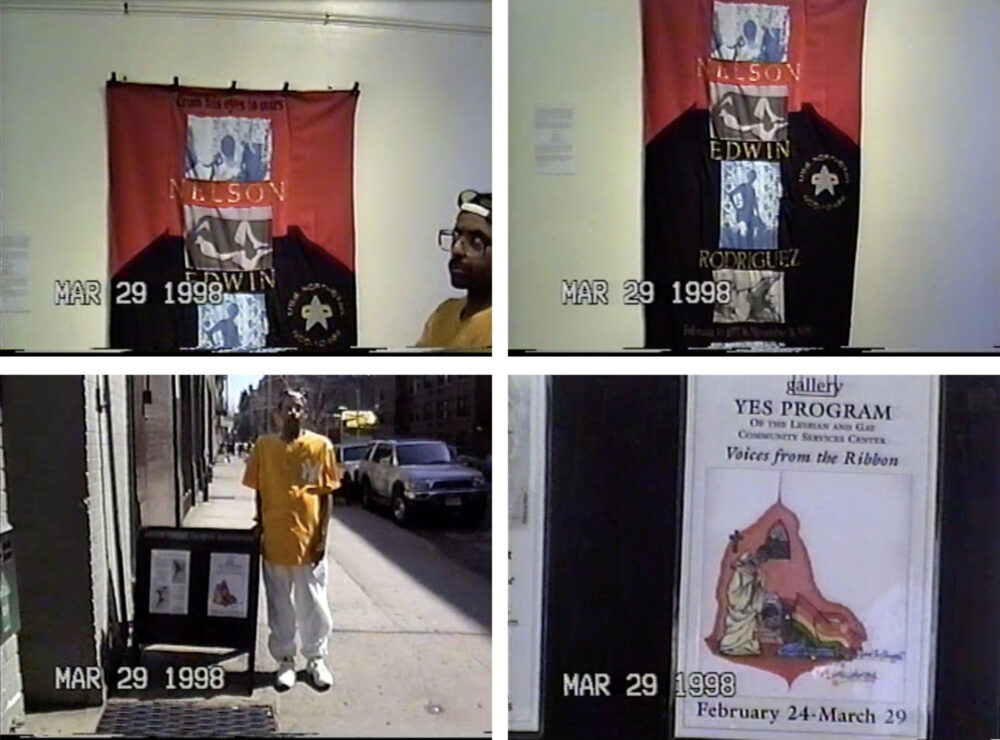
After Nelson’s passing, a series of two exhibitions titled Voices From the Ribbon hosted by the Youth Enrichment Services (YES) of the Lesbian & Gay Community Services Center brought together the photography of the late Nelson with the drawings of Milton Garcia. The first of these exhibitions took place in 1997 at the Center itself, and in 1998 at the Dance Theater Workshop on 219 West 19th Street.19 In a newly digitized videotape kept by Milton, one can see a recording and guided tour from the closing day of the 1998 exhibition. Around 18 of Nelson’s photographic prints were shown, shot in 1993 and processed at Hetrick-Martin. In the video, Milton describes the photographs as either self-explorations or personas developed by Nelson as a means to cope with his HIV diagnosis. Milton exhibited 23 different drawings, including a commemorative piece titled Red Ribbons in the Sky (1997) remembering Nelson and other friends who had passed away due to AIDS related complications . Two other works were also exhibited: a digital commemorative poster created by Andres Alberto Montoya-Montes, and Nelson’s AIDS memorial quilt panel created by David Moschel. This memorial quilt―composed of a background of intersecting red over black fabric panels―included the name “NELSON EDWIN RODRIGUEZ” in bedazzled gold lettering, five fabric transfers of black and white photographs stitched onto the quilt, with the text “from his eyes to ours” on the top of the quilt and “self portraits” on the bottom, this last segment referring to the five transfers of Nelson’s photographs as the main components of the quilt’s composition. The quilt was donated to the National AIDS Memorial Quilt project to be displayed in Washington, and it is currently part of block number 5339.20
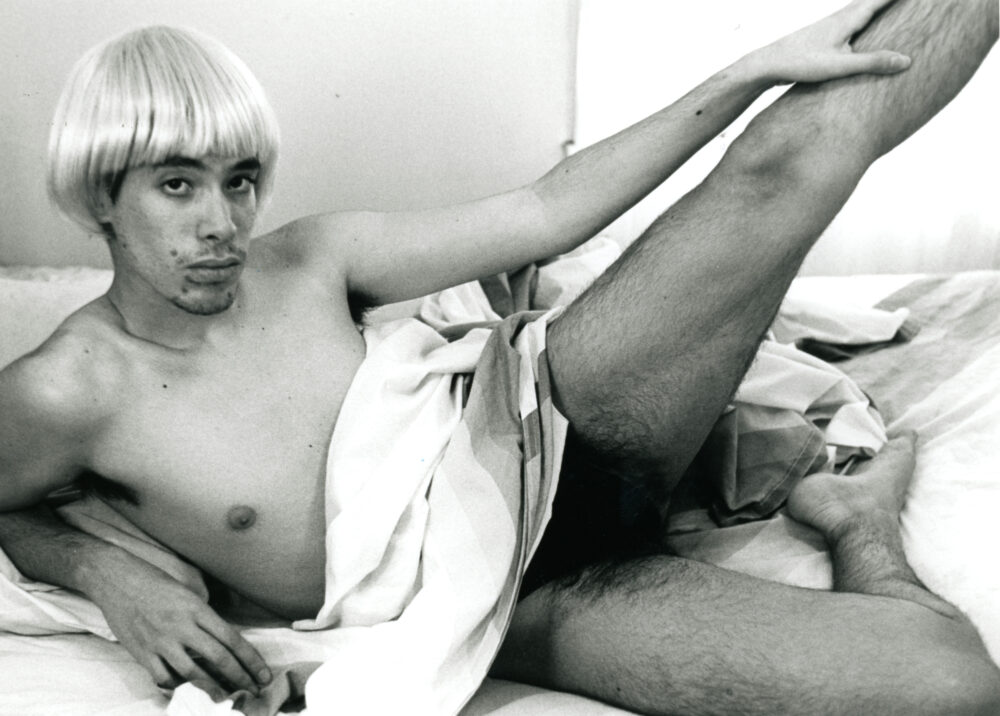
Autobiographical Photography in the Open Field of Gender
Gay men’s “obsession” with sex, far from being denied, should be celebrated―not because of its communal virtues, not because of its subversive potential for parodies of machismo, not because it offers a model of genuine pluralism to a society that at once celebrates and punishes pluralism, but rather because it never stops re-presenting the internalized phallic male as an infinitely loved object of sacrifice. Male homosexuality advertises the risk of the sexual itself as the risk of self-dismissal, of losing sight of the self, and in so doing it proposes and dangerously represents [ecstasy] as a mode of [praxis].21
Leo Bersani
The first works of Nelson’s oeuvre that captivated my attention were his many self-portraits taken at his own apartment in the Bronx. In one shot he allows us to peer into the intimacy of his bed, reclining on his right side and facing the camera in a three-quarter position. The expression is sly and coquettish with his natural beauty marks, his eyes boldly locked into the camera’s lens over a five o’clock shadow and under a darling platinum bob wig matched with a contrasting set of bushy dark-eyebrows. The attitude is daring, yet genuinely somewhat vulnerable. His left leg projects out of the light-colored sheets in a high diagonal like that of a Rockette showgirl, while his other leg delicately curves inward so as to support the pose. The dark pilosity of his legs is accented by the black colored underwear peeking underneath the sheets. The remaining surface area of the sheet carefully conceals his left breast, while his right nipple remains exposed. This photograph can easily represent the canon of Nelson’s visionary queerness: equal parts deliberate and naive, a rigorous photographic study that benefits from a high sense of intuition and precariousness. With a radical openness to move between seemingly disparate signifiers of gender―the thick dark hair under the armpits, on the legs, or peeking through the unshaven face that “betray” the general poise of the blonde diva―Nelson takes a low-fi approach to a simple set of materials that in turn project over-the-top fantasies of glamorous desire.
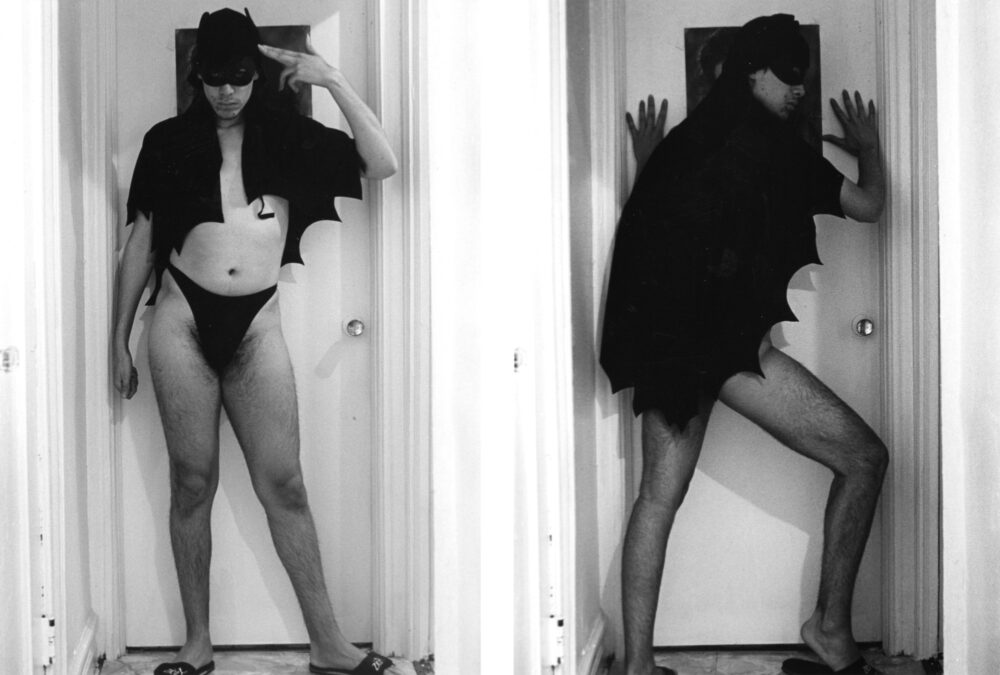
As easily as Nelson would jump into femme drag, he would weaponize the same humor to unpack Western icons of masculinity. I adore Nelson’s hilarious series on Batman, where he explores (again, in the privacy of his home) the recognizable icon of the superhero in the bat-shaped mask and jagged black cape. Counterpoint to the idealized masculine traits of the superhero, the naked latinx body and the reemergence of the black thong (seen as well in the previous photo here discussed) make evident the subtextual homoeroticism of the hero, and its veneration of patriarchal strength and financial dominance over the Othered nemeses of Gotham City.22 There is a marvelous solitude in many of Nelson’s works, especially in those captured in his own place. In another text, I reckoned with the importance of the care and solace of private space in the life of queer creatives under the axiom a room of one’s own with wifi.23 Even at the dawn of the democratization of the internet, there is a point to be made in the analysis of Nelson’s body of work about the correlation between the self-exploration and containment gained inside of private space and its potential to generate repercussions on a wider marginalized community through the use of a medium such as photography. Nelson’s photos are a vitrine into queer private space and their blossoming fantasies, much like the disco or the Ball are semi-clandestine territories that titillate between the public’s visibility and the private’s invisibility.
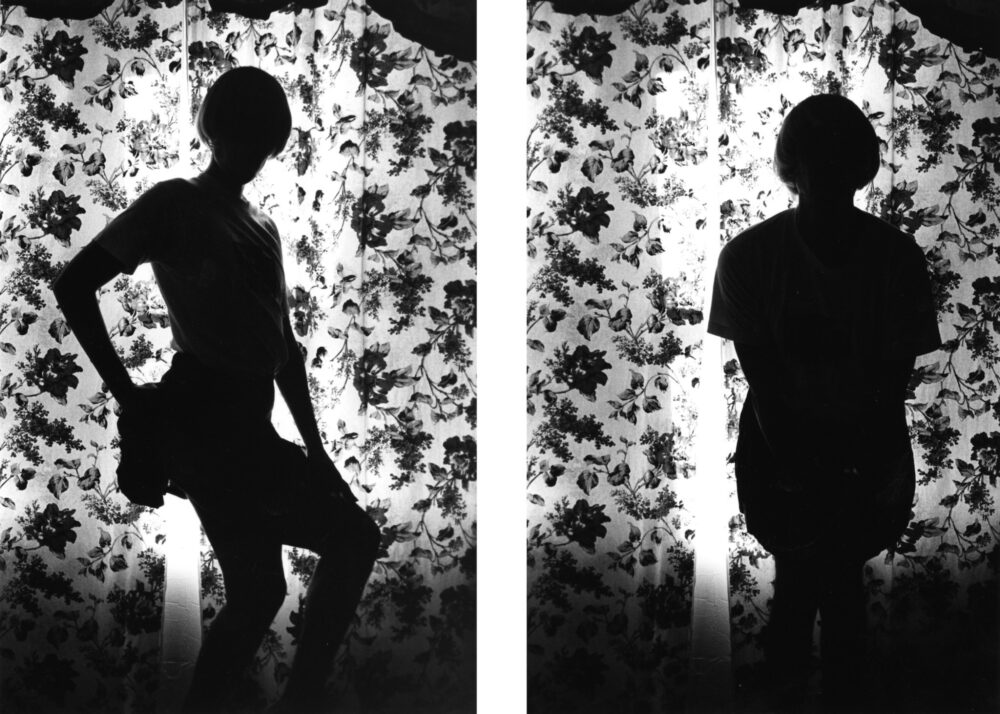
A second point is to be made in regards to the beautification of queer private space in Nelson’s oeuvre. The self portrait of Nelson sitting in his wooden armchair lined in velvet is breathtaking, his head looking down while his open palms stretch out behind his nape. This is part of a series of self-portraits in which Nelson poses wearing a white t-shirt printed with the logo of the Center and a pleated flannel skirt, later removing the skirt and remaining in a pair of tighty-whities. Behind him, the flower curtains that are found in so many of his shots―an ever-present prop in his limited set of tools―as well as the radiator, beat-up vinyl floor, and the neoclassic boiserie moldings on the wall.
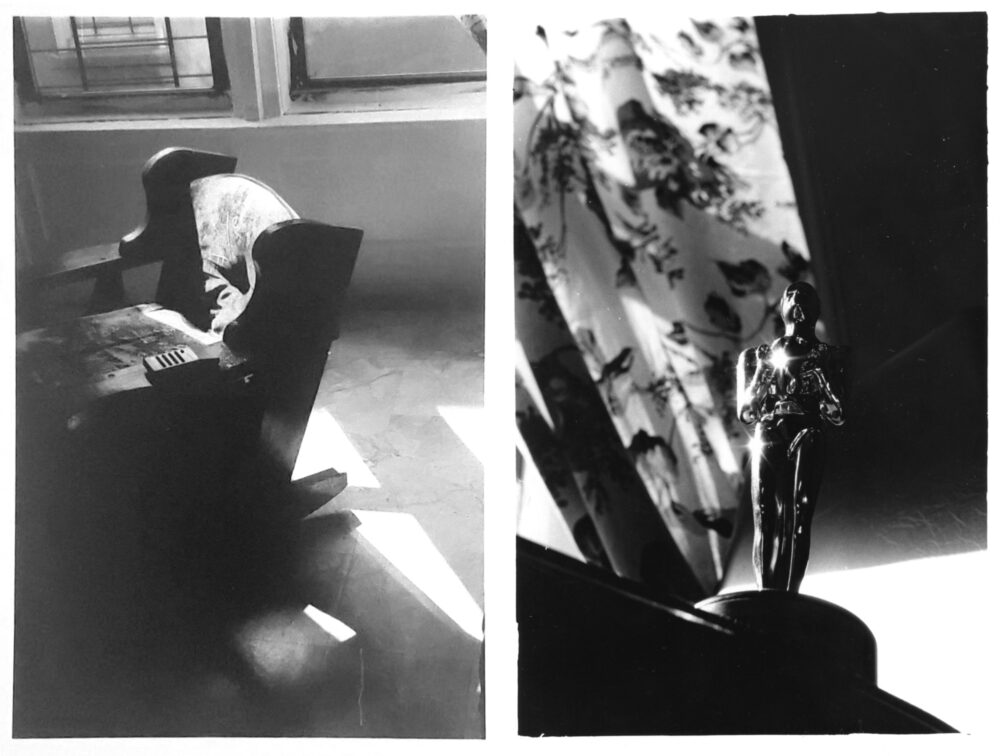
Even amidst material precarity, us queers will always find ways to beautify our surroundings, creating fantasies strung over temporary rentals with textures and fabrics that generate a sense of acceptance; where even our innermost turmoil can find a placid environment in which to nestle and be.24 For instance, Luna’s favorite shot of Nelson is his minimalist interior of the velvet armchair with the remote on the left arm, with the sunlight bleeding through the window sill. There is something so magical to be found in even the most banal of situations, in the interaction of light with the everyday objects that are given a second life through a decentered photographic gaze. Or in the tongue and cheek photo of the fake Oscar statuette, with the infamous flower curtains backlit in the background and an opportune sparkle of light bouncing from the middle of the artificial award. Nelson’s acting career was reaching new heights after his first supporting role in an independent feature film, The Incredibly True Adventure of Two Girls in Love directed by Maria Maggenti and released in 1995, but was cut short due to systemic negligence and the inaccessibility of antiretroviral cocktails. Who knows, without the given time and resources, if Nelson couldn’t have obtained an impressive award.
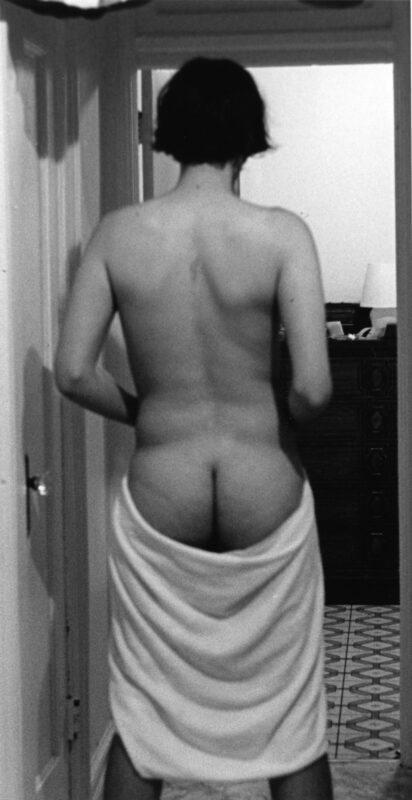
I would like to conclude this brief meditation surrounding some of Nelson’s memorable photographs by visiting the self portrait of his naked back in the hallway of his flat. In the far background, a glimpse into Nelson’s bedroom where we can faintly make out a messy dresser with a lampshade on it. Nelson is standing in the doorway, the door wide open away from the camera. On the left margin, another shut door with its transparent acrylic knob which we can only imagine where it might lead. A white fabric is draped concealing part of his legs, while his round, voluminous latinx buttocks are revealed for the spectator. There is a quiet vulnerability to Nelson’s composition, almost a bit timid while looking away from the camera, yes, but there is also a brave generosity in elegantly exhibiting the plumpness of his anal pleasure to the tacit observer of the photograph: be it a stranger like me, his peers at the Hetrick-Martin, or even for Nelson himself. There is a form of agency in becoming vulnerable and revealing oneself in this liminal space between rooms, mimicking the threshold between the outside world and the inside of the body through the rectum.
In researching and writing this essay, the least of my intentions would be to paint Nelson’s story as that of a victim. This is, while clearly denouncing the systems and institutions that failed Nelson―and generation after generation of queer folks―by ignoring and weaponizing the AIDS epidemic. I want to remember Nelson first and foremost as an artist and as a performer, who freely transitioned amongst mediums and genres in order to find his own voice as a young queer latinx individual. Who generously allowed us to peer through his artwork onto his own psychological landscape, navigating identity and oppressive patriarchal gender roles through kitschy humor and photography. Who bravely used art as a therapeutic means by which to understand, document, and testify to his own experience as a person living with HIV. Whose artwork also left us insight into his wider circle: a community of young, mostly brown and black queer creators, the challenges they faced, and also the wonderful joy of embodying their multifaceted and polyphonic25 gender expressions. In representing his own ass in the way that he did, Nelson could have been struggling with his own sexuality, facing the stigmas surrounding queerness inside latinx machismo culture, as well as the real possibility of death in a world where medical institutions and pharmaceutical companies could have saved thousands by making antiretroviral drugs widely available. However, I think that in this picture Nelson was also reminding us that the rectum has provided pleasure, containment, and self-actualization for the lives of many queer individuals of different identity coordinates. Our sexuality as queer people has been a cause for interior fear and contradictions, but it is our desires that will liberate our undying art and selfhood. This here is my loving reckoning with the queer anus of color as emancipatory politics.
About the Author
aliwen (they/she) is a trans* non-binary latinx artist and curator from Chile. Their main fields of interest are artistic and curatorial practices, performance theory, politics of dissent, new ecologies, and queer experiences intersected by race. Their first book, Barricade Criticism I. Body, Writing, & Visuality, was published by Brooklyn/Santiago based publisher Sangría Legibilities in 2021. They use artivism, exhibition-making, teaching, screenings, and writing to advocate against the stigma surrounding HIV/AIDS and queer experiences. They are currently enrolled in the Masters Program in Art Studies and Curatorial Practices at Tokyo University of the Arts and work as a Teaching Assistant at the Yuko Hasegawa Graduate Laboratory of that same institution. They hold a Bachelor with Honors in Art Theory and History from The University of Chile.
Works Cited
1. Emily Colucci, “Touch Across Time: Familial Loss And Its Remains In Art During The Ongoing HIV/AIDS Pandemic”, OnCurating, vol. 42 (2019): 281. https://www.on-curating.org/is...
2. I wanted to take this opportunity to extend my most sincere gratitude to the crowd of valuable individuals and institutions that supported me in being able to research and write about the visionary Nelson Edwin Rodriguez, to whom I feel extremely close to after having carefully reviewed his available artworks and documents. To Visual AIDS and its Programs Director Kyle Croft, for his constant kindness and support that was as equally efficient as respectful for the development of my own autonomous research process, as well as for his terrific copyediting. To Constantine Jones, a much admired artist and poet, also for their fabulous copyedit. To Kailee Faber, whose rigorous and politicized approach to the archive permitted me to access these important materials remotely, forever changing my life and my heart. To Michael Facius, for his geeky wisdom and camaraderie. To Lucy Fleming-Brown, for her caring loyalty and allyship. To all the people that knew and interacted with Nelson in life and maintain his memory to this day. To Barbara Bickhart, for having stimulated together with Bridget Hughes the performative practice of Nelson and so many other queer youths, and who also became entrusted with Nelson’s artistic estate. Also, to those contemporaries of Nelson that generously provided their valuable time for interviews, allowing me to access a more nuanced and experiential understanding of Nelson’s legacy. To the Legendary Voguer Milton Garcia from the House of Ninja, for his contributions to ballroom and to brown queer art, and for continuing to create together with Nelson even after his passing. To the Legendary Face Luna Luiz Ortiz from the House of Khan, also for his contributions to ballroom, as well as his early and constant advocacy, and for his powerful photographic oeuvre. To Lisa Ross, for their incredible belief in the artistic potential of queer youths, for having taught Nelson’s generation how to shoot photography, and for their own contributions not just as an educator but as an amazing artist in their own right. Finally, to Nelson, who showed me that art and playful exploration will always prevail over misunderstanding and neglect. Thank you Nelson for this queer embrace, that transcends space and time.
3. About the dispute over the gender-inclusive version of the concept of Latin@ and Latinidad, I was raised a native Spanish speaker and thus it seems most obvious for me to follow the speaking (and, concurrently, political) trends that are going on inside of this particular tongue, even when carrying these concepts to other languages. I use the concept “latinx,” in which the ending employs an “e” sound, and the usage of the “x” consonant is a punk gesture to denaturalize the mind’s eye to normative, two-toned gender structures and linguistic conventions, opening-up to ever-changing manifestations of gender and sexuality beyond the binary.
4. Élisabeth Lebovici, Sida (Barcelona: Arcadia MACBA, 2020): 39. Translation from Spanish is mine.
5. José Esteban Muñoz, Cruising Utopia: The Then and There of Queer Futurity (New York: New York University Press, 2009).
6. Although varying greatly among institutions and contexts, the Hetrick-Martin (and other similar queer youth services) used to define their target demographic from early adolescence at 13 years old to the cut-off age of 22 years during Nelson’s participation in their programs, raising the bar more recently to 24 years of age.
7. Hetrick-Martin was born from the initiative of a gay couple comprised of the psychiatrist Emery Hetrick and educator and speech impediment specialist Demian Martin, after they heard the story of a 15-year-old boy who was kicked out of a youth shelter due to his sexual orientation. They named themselves Institute for the Protection of Lesbian and Gay Youth (IPLGY) and met together with other advocates in their apartment located at 144 East 36th Street to tackle ways in which to improve the situation of homelessness amongst queer youth in New York. In 1983, the IPLGY received an anonymous donation which was then matched by the first public grant of the New York State Division for Youth. This funding allowed them to open a drop-in center in the entire third floor of the building at 112 East 23rd Street, where they began providing shelter and counseling for queer youth. Later the IPLGY expanded their focus to the issue of truancy among queer students—the chronic absence or dropping-out of schooling due to issues such as discrimination, harassment, and violence. Together with the New York City Department of Education, in 1985 they created the Harvey Milk High School (HMHS) which catered to the education of queer and questioning youths, opening first at the Washington Square United Methodist Church, later that year moving to the then Lesbian & Gay Community Services Center also known as “the Center” located in 208 West 13th Street. In 1986, the IPLGY moved into the next door building at 110 East 23rd Street in order to also accommodate the HMHS in the same location. After the tragic passing of Emery Hetrick in 1987 due to AIDS-related complications, the IPLGY changed its name to the Hetrick-Martin Institute (HMI). Sadly, Demian Martin also passed away from AIDS-related complications some years later in 1991. “A. Damien Martin, 57, A Gay Rights Advocate”, New York Times, August 18, 1991, Section 1, 30. https://www.nytimes.com/1991/0...
It was around 1987 and 1990 that the operations of the HMI moved to their location on West Street near the West Side Piers, seeking to capture the attention of vulnerable queer youth through “a street outreach crew that worked at night on the piers in Greenwich Village.” Ken Lustbader, “Institute for the Protection of Lesbian and Gay Youth”, NYC LGBT Historic Sites Project (March 2017). https://www.nyclgbtsites.org/s...
It was probably around 2002 when management of HMHS passed to the Department of Education, and both HMI and HMHS moved to a new location at 2 Astor Place. For more information, visit the Institute's website: https://hmi.org/
8. Although Visual AIDS’ Artist+ online registry―as well as the web gallery “(Auto)Biography: The Photography of Nelson Edwin Rodriguez” curated by Boris Torres and Ira Sachs―list Nelson’s date of birth as 1974, a memorial text created by fellow artist Luna Luis Ortiz after Nelson’s passing defines his year of birth as 1972 and his year of death as 1995. Nelson’s AIDS memorial quilt states his lifespan as February 16th, 1972 to November 14th, 1995. Nelson’s Visual AIDS Artist Registry page was updated with these dates at the time of publication.
9. Boris Torres and Ira Sachs, “(Auto)Biography: The Photography of Nelson Edwin Rodriguez”, Visual AIDS Web Gallery (December 2010). https://visualaids.org/gallery...
10. Lisa Ross, interview with author, September 16, 2022.
11. Ryan White was a teenager from Indiana diagnosed with HIV in December 1984 at age 13, who acquired the virus due to a blood transfusion required by his hemophilic condition. He was not allowed to return to study at his local Western Middle School due to contracting HIV, which fostered much attention from the media. Ryan and his mother Jeanne White-Ginder (who now goes by Jeanne Elaine Hal) became advocates against the stigmatization of people living with HIV/AIDS regardless of the way in which they acquired it, and raised funds for HIV/AIDS research, healthcare, and initiatives. After his passing in 1990, the Ryan White Comprehensive AIDS Resources Emergency (CARE) Act was passed in the United States Congress, allowing for people with little or no insurance to access treatment for HIV/AIDS.
12. Luna Luis Ortiz, interview with author, August 18th, 2022.
13. Folder 2 of Box 50 of the Visual AIDS Archives contains the materials linked to Nelson Edwin Rodriguez. Amongst them, a fax dated September 14th, 2000 sent from the then Assistant Director of Visual AIDS Nelson Santos to Barbara Bickhart describes that they were in communications in order to learn more about Nelson’s life and artwork. This fax also asks Barbara to sign a Release Form in order to reproduce some of Nelson’s photographs in the webpage of Visual AIDS, which was the basis for the current Artist+ online registry. This can lead us to believe that Barbara herself donated part of Nelson’s body of work today held by Visual AIDS, however the fax itself makes explicit how they already had “a sheet of unlabeled slides in the office” containing more of Nelson’s work.
14. The Center Voice, “Center Youth Group Has High Visibility in City Conference”, The Center Voice, vol. 7, num. 6, December 1991, 1.
15. This same printed matter also provides a full listing of Alternate Vision’s theater practice to the date: “Alternate Visions, 1989; Sekret Rainbows, 1990; Divided by Normal, 1991; It’s Not the Shoes that Danced Themselves to Pieces; A Queer Fairy Tale, 1992; and Soul Cages, 1993.”
16. Nelson also admired the campy femininity of Deanna Troi’s mother in the show, Lwaxana Troi, with her elaborate costuming, eccentric personality, and incredible ability to empathize and connect with the thoughts and feelings of others.
17. Milton Garcia, interview with author, July 28, 2022.
18. The text I used for this transcription comes from Luna Ortiz’ personal archive, and he wrote this himself as a commemorative text shortly after Nelson’s passing.
19. The exhibition at the Center had an opening reception on February 20, 1997. The exhibition at the Dance Theater Workshop was on view from February 24–March 29, 1998 with an opening reception on March 1st.
20. You can search for Nelson’s quilt in the website of the National AIDS Memorial Quilt project: https://www.aidsmemorial.org/i...
21. Leo Bersani, “Is the Rectum a Grave?”, Is the Rectum a Grave?: and Other Essays, (Chicago: The University of Chicago Press, 2010): 30.
22. A queer reading of the DC superhero Batman can be drawn through Bruce Wayne’s traumatic childhood which ripped him away from his family, finding autonomy through wealth and social mobility at a metropolitan center, living a duplicitous life in which he must put on a mask to let his alter ego free and fight for what he deems as social justice. The comic released for the 2022 DC Pride Anthology telling the life story of Kevin Conroy, the late actor and voice of the cartoon version of Batman since 1992, details his struggles with coming out, employment discrimination, and substance abuse as well as the HIV epidemic and personal reckoning and success.
23. aliwen, “kuir confinements: making an anti-normative gesture out of living”, Terremoto, vol. 18, (May 21, 2020). https://terremoto.mx/en/revist...
24. There is a particular intersection between campy interior beautification and queer latinx experiences. For instance, Chilean drag/transvestite/trans author and playwright Iván Monalisa Ojeda arrived in New York in 1996, and has written about the experiences of undocumented, trans, and queer sex workers. In one said short story, titled “House of dreams” which appeared in his book La misma nota, forever published by Sangría Legibilities (Brooklyn/Santiago), Ojeda narrates about a transgender latina sex worker that transforms her precarious living quarters into a welcoming, almost mystical paradise using only light-catching surfaces such as metallics, satins, and mirrors: “Lo transformó en un cuarto hermosamente kitsch, donde abundaba el plateado, el dorado y el blanco de las paredes. Muchos espejos y, en un rincón de la cama, que era un colchón en el suelo, rodeado de satín celeste y transparencias, una pequeña mesa que simulaba un bar, donde lo que nunca faltaba era el vodka, el Bacardí y el tequila. Sobre una cómoda pintada de blanco y dorado había una pequeña imagen del buda feliz para la abundancia y la buena suerte, rodeado de billetes de un dólar y uno que otro de cinco y de diez.” Iván Monalisa Ojeda, “House of dreams”, La misma nota, forever (New York/Santiago: Sangría Legibilities, 2014): 57-62.
25. On queer feminist polyphony as territory of artistic and political intervention, Yuka Kanno describes a practice that: “resist uniformity and places value in ambiguity. It is an attempt to read the conflicts and tensions between women [and queer/queder-non-conforming people] in places where the meanings of words and images sideslip, derail, and are pluralized.” Yuka KANNO, “An opaque feminist/queer polyphony”, wendelien van oldenborgh. unset on-set (Tokyo: Museum of Contemporary Art Tokyo & torch press, 2022): 25.